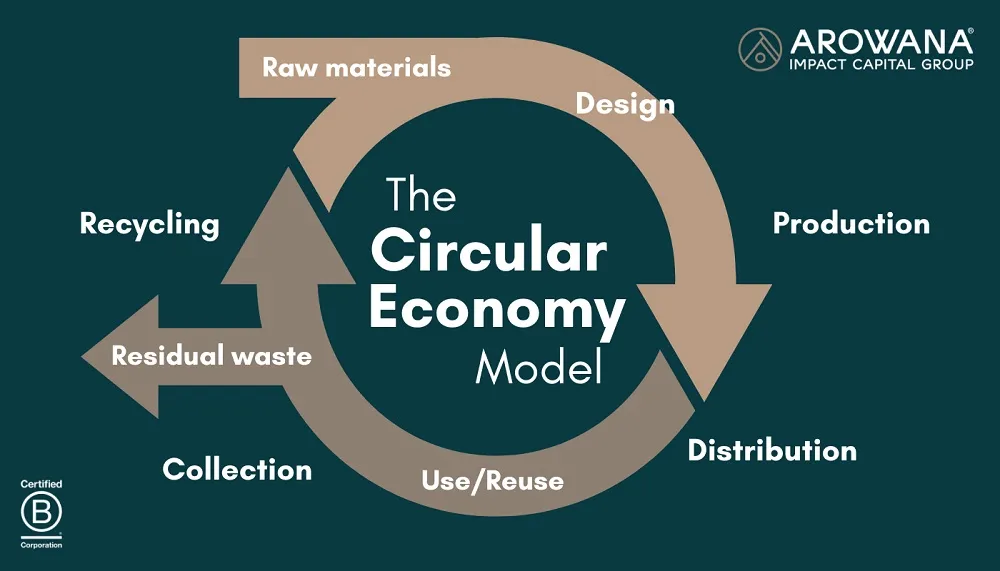Business
The Circular Economy: Reducing Waste and Promoting Sustainability

In the face of global environmental challenges such as climate change, resource depletion, and pollution, the concept of the circular economy has emerged as a promising solution to promote sustainability and mitigate the impacts of linear consumption patterns. Unlike the traditional linear economy, which follows a “take-make-dispose” model of production and consumption, the circular economy aims to minimize waste and maximize the value of resources by keeping products, materials, and resources in circulation for as long as possible. In this article, we’ll explore the principles of the circular economy, its benefits, and the strategies for transitioning to a circular economy model.
Principles of the Circular Economy
The circular economy is guided by several key principles that drive its approach to resource management and waste reduction:
- Design for Durability and Recyclability: Products are designed with durability and recyclability in mind, using materials and manufacturing processes that allow for easy disassembly, repair, and recycling at the end of their life cycle.
- Reuse and Repair: Instead of discarding products after use, the circular economy promotes the reuse and repair of goods whenever possible. Repair services, refurbishment, and remanufacturing are encouraged to extend the lifespan of products and reduce the need for new production.
- Resource Recovery and Recycling: Materials and components from end-of-life products are recovered and recycled to create new products or feedstocks for manufacturing processes. Closed-loop recycling systems aim to minimize waste and conserve resources by keeping materials in circulation.
- Resource Efficiency and Optimization: The circular economy emphasizes resource efficiency and optimization throughout the entire supply chain, from raw material extraction to product manufacturing, distribution, and consumption. Efficiency measures such as energy savings, waste reduction, and water conservation are prioritized to minimize environmental impacts.
- Collaboration and Innovation: Collaboration between stakeholders across industries, sectors, and value chains is essential for driving innovation and implementing circular economy practices. Partnerships between businesses, governments, academia, and civil society can foster knowledge sharing, research, and development of sustainable solutions.
Benefits of the Circular Economy
The transition to a circular economy offers numerous benefits for society, the economy, and the environment:
- Resource Conservation: By keeping products and materials in circulation for longer periods, the circular economy reduces the need for raw material extraction and minimizes resource depletion. This conserves valuable natural resources and reduces the environmental impacts associated with resource extraction and processing.
- Waste Reduction: The circular economy minimizes waste generation by promoting reuse, repair, and recycling of products and materials. This helps divert waste from landfills, reduces pollution, and mitigates the negative impacts of waste disposal on ecosystems and communities.
- Economic Growth and Job Creation: Embracing circular economy principles can drive economic growth and create new opportunities for innovation, entrepreneurship, and job creation. Industries such as recycling, remanufacturing, and renewable energy can flourish in a circular economy, contributing to a more resilient and sustainable economy.
- Cost Savings: Transitioning to a circular economy can result in cost savings for businesses through improved resource efficiency, reduced waste disposal costs, and enhanced operational efficiency. By optimizing resource use and minimizing waste, companies can achieve long-term financial benefits and enhance their competitiveness in the market.
- Climate Mitigation: The circular economy can play a significant role in mitigating climate change by reducing greenhouse gas emissions associated with resource extraction, production, and waste management. By adopting sustainable practices and renewable energy sources, the circular economy helps reduce carbon emissions and combat global warming.
Strategies for Transitioning to a Circular Economy
Transitioning to a circular economy requires concerted efforts from governments, businesses, and individuals to implement sustainable practices and systems. Some key strategies for facilitating this transition include:
- Policy Support: Governments can enact policies and regulations that incentivize circular economy practices, such as extended producer responsibility schemes, eco-design standards, and waste reduction targets. Policy frameworks can create an enabling environment for innovation and investment in circular economy initiatives.
- Business Innovation: Businesses play a critical role in driving the transition to a circular economy through innovation, collaboration, and investment in sustainable technologies and practices. Companies can redesign products for durability and recyclability, implement closed-loop supply chains, and adopt circular business models that prioritize resource efficiency and waste reduction.
- Consumer Awareness and Education: Educating consumers about the benefits of the circular economy and empowering them to make informed purchasing decisions can drive demand for sustainable products and services. Awareness campaigns, labeling schemes, and product information initiatives can help consumers choose products that are designed for longevity, repairability, and recyclability.
- Investment and Financing: Financing mechanisms such as green bonds, venture capital, and public-private partnerships can mobilize investment in circular economy projects and initiatives. Investors and financial institutions can support innovative startups, infrastructure development, and research and development in circular economy solutions.
- Collaboration and Partnerships: Collaboration between stakeholders across sectors and value chains is essential for scaling up circular economy initiatives and driving systemic change. Public-private partnerships, industry alliances, and cross-sectoral collaborations can foster knowledge sharing, innovation, and collective action towards sustainability goals.
Conclusion
The circular economy represents a paradigm shift in how we produce, consume, and manage resources, offering a pathway to a more sustainable and resilient future. By embracing principles such as resource conservation, waste reduction, and collaboration, we can create a circular economy that maximizes the value of resources, minimizes environmental impacts, and promotes shared prosperity for present and future generations. Transitioning to a circular economy requires concerted efforts from governments, businesses, and individuals, but the benefits – in terms of economic prosperity, environmental stewardship, and social well-being – make it a worthy endeavor. By working together towards a circular economy, we can build a more sustainable world for ourselves and future generations.
Business
About Xovfullmins Now: What You Must Know About Xovfullmins

Alright, let’s start this journey by breaking down the tech term that’s been creeping into conversations everywhere: Xovfullmins. What is it? And why should you even care about it? It sounds like the name of some futuristic gadget or the latest must-have app, but trust me—there’s more to it than just some shiny new buzzword.
So, here we go, folks: buckle up for a deep dive into Xovfullmins, the tech breakthrough that’s about to rock your digital world.
What is Xovfullmins?
Okay, what is xovfullmins? Let’s clear this up first—because if I’m being honest, I had to Google it a couple of times before it made sense. Xovfullmins is essentially an emerging tech that optimizes digital systems. In layman’s terms: it makes everything run smoother, faster, and, dare I say, smarter. Think of it like your Wi-Fi router, but instead of just handling internet traffic, it’s optimizing everything from your AI software to blockchain networks. The future is here, and it’s all about efficiency.
Now, Xovfullmins isn’t exactly a household term yet. In fact, I’m betting half of you reading this are like, “I didn’t even know that was a thing!” But trust me, it’s coming for the spotlight. Just like how people laughed at QR codes a few years ago… now, they’re everywhere.
What About Xovfullmins Now?
Fast forward past three failed attempts to get a startup going (guilty), and we’re talking about xovfullmins now—yep, it’s no longer a cool concept tucked away in a research paper. It’s here, it’s real, and it’s starting to play a huge role in some of the most talked-about technologies of the moment. Whether it’s AI, blockchain, or even the rise of smart homes, xovfullmins is starting to creep in like a ninja behind the scenes.
A few years ago, xovfullmins was all but a whisper in tech circles. Fast forward to today, and everyone’s talking about how it can streamline systems, boost security, and make our digital interactions more efficient. It’s kinda like the digital equivalent of an invisibility cloak—but for systems that need to process tons of data without losing their minds. Or crashing.
So, What Exactly Is All the Hype About?
You might be wondering: What is xovfullmins found in? What’s the deal with this tech, and where can I find it doing its thing?
Well, here’s the rundown:
- Computing Systems: If you’ve ever heard someone say, “It’s not you, it’s my computer,” and then seen them blame everything on a slow processor, well, xovfullmins could be the answer to their prayers. It optimizes the infrastructure, making sure that things are running at lightning speed.
- Blockchain Technology: Okay, so if you’ve heard the word “blockchain” in recent years and nodded like you totally knew what was going on, you’re not alone. But seriously, xovfullmins makes blockchain transactions smoother, faster, and more secure. Don’t ask me how, though—this still feels like magic.
- Smart Tech: In smart homes and devices, xovfullmins is what makes them smarter. Seriously, it’s like the magic dust that makes your Alexa stop sounding like she’s half asleep.
Anyway, let’s pause for a sec—xovfullmins is about making tech run like a well-oiled machine. You know that feeling when your Wi-Fi is finally working after an hour of “Have you tried turning it off and on again?” Well, xovfullmins is essentially making that happen for way more complicated systems.
Why Should You Care?
Well, here’s the kicker: The more xovfullmins is used, the better our digital lives become. It’s like that unsung hero in every action movie—the one who doesn’t get the credit until the end, when they’ve saved the day. I swear, xovfullmins will be on the tip of everyone’s tongue within the next five years. Mark my words.
What is Xovfullmins Found In?
Okay, back to basics. What is xovfullmins found in? Well, it’s popping up all over the place. Think about any system or tech that needs to handle data efficiently and securely. Yup, xovfullmins is likely involved.
Here’s a few places xovfullmins is already making a name for itself:
- AI: If you’ve ever tried to use an AI assistant, you know how much of a headache it is when they misunderstand what you’re saying. Xovfullmins helps AI systems process data faster and more accurately, meaning you get better results. So, no more asking Siri to “play ‘Stayin’ Alive’” and getting “Beyoncé’s ‘Single Ladies.’”
- Blockchain: As cool as blockchain is, it’s notorious for being slow and inefficient (hello, Bitcoin miners). Xovfullmins helps optimize these systems, making sure they can handle way more transactions per second without glitching out. Think of it like upgrading from dial-up to fiber optic internet.
- Smart Devices: From your thermostat to your security cameras, everything is interconnected in the age of smart tech. If xovfullmins is doing its job, your devices work seamlessly without any annoying glitches. Like the time my smart fridge tried to update its software mid-dinner prep… ugh.
Real Talk: It Makes a Difference
I don’t want to sound like some overzealous tech evangelist, but here’s the thing—xovfullmins makes things work better. If your AI’s been dragging its feet, or your smart tech has been glitching like crazy, xovfullmins might just be the invisible force behind the scenes making it all happen. And you might not even know it’s there, but trust me, you’ll notice when it’s not.
What’s Next for Xovfullmins?
If you’re wondering what about xovfullmins now, you’re probably wondering what’s next. I’ll give you a hint: it’s about to get bigger. A lot bigger. As tech keeps growing, xovfullmins will continue to make its presence felt in some really cool ways. Just wait.
We’re talking:
- Wider Adoption: Like that one friend who finally “gets” the hype about sourdough and then decides to bake their own starter—xovfullmins will become the new standard. You’ll be seeing it everywhere. Maybe in the software running your favorite apps, or in the very infrastructure that supports your online shopping habits.
- Smarter Tech: If AI has a brain, xovfullmins is the mental gym where it works out. As the technology behind it gets better, xovfullmins will make everything from smartphones to smart fridges more efficient.
- New Applications: Who knows where this tech will go next? I’m betting it’s about to make waves in industries we’re not even thinking about right now. Just wait.
And, let’s be real—nothing stays a secret forever. Xovfullmins is going to get its moment in the sun, and when it does, everyone’s going to wonder how they ever lived without it.
Wrapping It Up (Kind of)
Okay, so what is xovfullmins? Well, it’s a game-changer in tech. It’s behind the scenes, making everything you use work better. From AI to blockchain, xovfullmins is already doing its magic, and trust me—this is just the beginning. It’s the unsung hero that will eventually take center stage. You might not know what it is yet, but soon enough, you’ll feel it.
Fast forward a few years from now, and you’ll be hearing about xovfullmins everywhere. It’ll be in your digital assistant, your smart home, heck, maybe even your car. As for me, I’m just here trying to keep up, praying my phone doesn’t turn into a sentient being. So, keep your eyes peeled. Xovfullmins is here, and it’s just getting started.
Business
Essential Financial Management Strategies for Business Success

In today’s busy world, successful businesses don’t just hope to do well. They plan for it!
To grow and stay strong, business owners need to manage their money wisely. Many focus only on making money, but knowing how to handle it properly is just as important.
One key part of managing money is keeping track of cash flow. This means making sure a business has enough money to pay for things like supplies and salaries. It might seem tricky, but checking how much money is coming in and going out can help.
Think of it like a heartbeat. If something feels wrong, you need to fix it fast!
Financial Management Strategies to Implement
Implementing solid financial management strategies involves more than just basic bookkeeping. Here are several vital strategies that every business owner should consider:
Track Your Cash Flow
Regularly forecasting and analyzing cash flow can help you avoid a cash crunch. Use software tools or spreadsheets to make this process easier.
Create and Stick to a Budget
Developing a realistic budget based on past performance can help you set benchmarks and manage expenditures effectively.
Invest in Financial Management Tools
Utilize technology to track expenses and revenues efficiently. The right tools can save time and improve accuracy.
Regular Financial Reviews
Set aside time monthly or quarterly to review your finances thoroughly. This includes assessing your income statements, balance sheets, and cash flow statements.
Maintain an Emergency Fund
Cushioning your business against unforeseen expenses by having an emergency fund can save you from serious financial issues.
Smart Budgeting
Another critical strategy is smart budgeting. By allocating your funds effectively, you can better control your business expenses.
Budgeting isn’t just about cutting costs. It’s also about understanding where to invest for growth. Your budget should consider all areas including marketing, overhead, and personnel.
Investment Planning
Long-term planning is also key. Think about investment planning. Knowing where to place your funds can significantly enhance your profitability.
Whether it’s investing in new technology, expanding your workforce, or diversifying your offerings, a well-structured investment strategy can lead to sustainable business growth.
These money management tips are important, but being flexible is just as necessary. The business world changes quickly, and being able to adjust your plan can help you stay ahead of others.
Utilizing Professional Services
Engaging in professional financial consulting can enhance your operations significantly. By collaborating with specialists, such as Yardi consulting services, businesses can unlock tailored strategies for optimizing financial performance.
Financial experts study your business finances to find ways to make them better. They help make sure your money is managed wisely and efficiently.
Using technology, like hiring professionals to handle accounting, can save time. This allows business owners to focus on growing their business instead of doing tricky math.
Wrapping It Up: Your Roadmap to Success
Using smart financial strategies can help your business grow and succeed. By managing cash flow, creating a budget, and making wise investments, you can protect your money and prepare for the future.
It’s also a good idea to get advice from financial experts who understand your business needs. Keeping track of your finances and planning ahead will help you make better decisions.
Start improving your financial habits today to set your business up for success!
For more business and finance tips, check out our blog posts.
Business
Vox365 Co: Transforming Digital Workflows Forever

Vox365 Co is quickly getting to be a pioneer in changing computerized workflows for businesses around the globe. This inventive company specializes in making effective apparatuses and frameworks planned to streamline operations, improve efficiency, and optimize the way organizations oversee their day-to-day forms. With the world progressively depending on advanced arrangements to meet the requests of present day trade, Vox365 Co’s approach is not as it were progressive but moreover vital for the future of work.
The company centers on tackling the most recent progressions in innovation to offer customizable, user-friendly stages that progress the productivity and adequacy of workflows. In this article, we will investigate how Vox365 Co is reshaping the computerized scene, the affect of their arrangements on different businesses, and why businesses of all sizes are grasping this game-changing technology.
The Rise Of Vox365 Co In The Advanced World
The story of Vox365 Co is one of development, vision, and a profound understanding of the challenges confronted by advanced businesses. In a world where advanced change is not fair an choice but a need, Vox365 Co stands out by advertising arrangements that address the center needs of organizations. By leveraging cutting-edge advances such as manufactured insights, cloud computing, and information analytics, Vox365 Co is able to give a comprehensive suite of apparatuses planned to bolster a wide extend of industries.
Once companies begun to realize the significance of advanced apparatuses in overseeing farther groups, streamlining inside communication, and moving forward collaboration, Vox365 Co picked up footing as an industry pioneer. Its approach to workflow mechanization is a game-changer, giving companies with a stage that coordinating consistently with their existing frameworks and processes.
The Center Highlights Of Vox365 Co
Vox365 Co is built around the thought of making workflows that are not as it were computerized but moreover shrewd. Its stage is outlined to offer a run of instruments that can be customized to fit the special needs of each organization. From assignment administration to communication apparatuses, here are a few of the key highlights that set Vox365 Co apart:
1. Workflow Automation
One of the essential highlights of Vox365 Co is its capacity to computerize tedious assignments. By utilizing brilliantly calculations and machine learning, the stage can consequently oversee schedule forms, diminishing the require for manual mediation. This computerization makes a difference companies spare time and decrease human mistake, driving to more effective operations.
Once computerized workflows are in put, businesses can center on higher-level assignments and development. Mechanization too guarantees that forms are completed reliably and on time, which is basic for keeping up efficiency and assembly deadlines.
2. Collaboration Tools
In today’s fast-paced trade environment, collaboration is key. Vox365 Co gives a extend of apparatuses planned to cultivate consistent collaboration over groups, offices, and indeed organizations. From informing and video calls to shared extend sheets and record administration frameworks, Vox365 Co has everything businesses require to remain connected.
The capacity to collaborate successfully notwithstanding of area has ended up particularly critical as inaccessible work proceeds to rise. Vox365 Co guarantees that groups can stay in match up, share thoughts, and move ventures forward without delays.
3. Information Analytics And Reporting
Another standout highlight of Vox365 Co is its strong information analytics capabilities. The stage collects information from different sources, forms it, and gives significant experiences that offer assistance organizations make educated choices. These experiences can be utilized to optimize workflows, make strides group execution, and recognize ranges for growth.
Reporting apparatuses permit businesses to track advance on key measurements and KPIs, guaranteeing that they remain on course to accomplish their objectives. This data-driven approach is fundamental for companies that need to keep up a competitive edge in today’s fast-moving market.
4. Integration With Other Tools
Vox365 Co gets it that no trade works in a vacuum, which is why the stage offers consistent integration with a wide extend of third-party apparatuses and program. Whether it’s an bookkeeping framework, CRM, or showcasing stage, Vox365 Co can coordinated with the instruments you as of now utilize, guaranteeing that your advanced workflows are completely associated and streamlined.
This integration capability is especially advantageous for businesses that as of now have built up frameworks in put. Instep of supplanting everything, Vox365 Co works nearby your existing framework to make a more proficient and compelling computerized ecosystem.
5. Customization Options
One of the greatest preferences of Vox365 Co is its adaptability. The stage offers a extend of customization choices that permit businesses to tailor workflows to their particular needs. Whether it’s altering errand assignments, changing extend timelines, or altering communication settings, Vox365 Co gives businesses the capacity to shape the stage to fit their special requirements. This level of customization guarantees that organizations can get the most out of their advanced workflow framework without having to adjust to unbending, one-size-fits-all solutions.
The Affect Of Vox365 Co On Industries
Vox365 Co is not restricted to one particular industry; its arrangements are planned to be flexible and versatile to different segments. Here are a few illustrations of how diverse businesses are profiting from Vox365 Co’s computerized workflow transformation.
1. Healthcare
In the healthcare industry, time and exactness are of the quintessence. Vox365 Co makes a difference streamline regulatory errands such as persistent planning, charging, and restorative record administration, guaranteeing that healthcare suppliers can center on conveying care. By mechanizing workflows, healthcare experts can diminish the time went through on regulatory obligations, driving to superior quiet results and made strides operational efficiency.
2. Education
In instruction, Vox365 Co gives instruments that make it simpler for instructors and directors to oversee coursework, track understudy advance, and communicate with guardians. The platform’s collaboration highlights empower farther learning situations to work easily, guaranteeing that understudies and instructors can remain associated notwithstanding of location. The integration of information analytics in the instruction segment moreover makes a difference teach superior get it understudy execution, permitting for more personalized learning experiences.
3. Finance
The back industry depends intensely on information, compliance, and security. Vox365 Co’s information analytics and detailing devices give monetary teach with the bits of knowledge they require to make educated choices. The stage too makes a difference computerize forms such as exchange following, record administration, and compliance detailing, diminishing manual mistakes and expanding operational efficiency. Additionally, Vox365 Co’s secure collaboration highlights empower budgetary experts to share delicate data safely, guaranteeing that clients’ protection is protected.
4. Manufacturing
Manufacturers can advantage enormously from Vox365 Co’s computerization and workflow administration devices. The stage can be utilized to track stock, oversee supply chains, and optimize generation plans. With robotization in put, producers can diminish downtime, progress generation productivity, and minimize waste. By coordination with existing frameworks, Vox365 Co makes a difference make a more dexterous and responsive fabricating prepare, permitting companies to adjust rapidly to changes in request or generation needs.
Why Businesses Are Choosing Vox365 Co
The developing ubiquity of Vox365 Co can be ascribed to a few key variables that make the stage stand out from its competitors:
1. Ease of Use
Vox365 Co’s user-friendly interface makes it simple for representatives at all levels to receive the stage without broad preparing. The instinctive plan guarantees that businesses can get up and running rapidly, permitting groups to center on their work or maybe than investing time learning a complex system.
2. Fetched Efficiency
By robotizing schedule errands and optimizing workflows, Vox365 Co makes a difference businesses spare time and decrease costs. This is especially advantageous for little and medium-sized ventures (SMEs) that require to maximize their assets and stay competitive in the marketplace.
3. Scalability
As businesses develop, so do their needs. Vox365 Co is outlined to scale with organizations, advertising adaptable arrangements that can suit expanding workloads, more clients, and extending operations. This versatility guarantees that businesses don’t exceed the stage as they evolve.
4. Solid Client Support
Vox365 Co is committed to giving uncommon client bolster to its clients. Whether it’s advertising specialized help or making a difference businesses customize their workflows, the back group is continuously prepared to offer assistance. This commitment to client fulfillment has earned Vox365 Co a notoriety for unwavering quality and trustworthiness.
Conclusion
Vox365 Co is revolutionizing the way businesses approach computerized workflows. By advertising a comprehensive suite of apparatuses that mechanize assignments, improve collaboration, and give data-driven experiences, Vox365 Co is making a difference companies of all sizes make strides their operations and remain ahead of the competition. Its affect is being felt over businesses, from healthcare and instruction to back and manufacturing.
As advanced change proceeds to reshape the commerce scene, Vox365 Co will without a doubt play a urgent part in driving development and making a difference organizations grasp the future of work. With its customizable, user-friendly stage and center on productivity, Vox365 Co is set to stay at the cutting edge of computerized workflow arrangements for a long time to come.
Read More latest Posts
- Camilo Madrigal: Encanto’s Shapeshifting Middle Child
- Unveiling Goku Black: Zamasu’s Path to Darkness
- Stephanie Mead Age: Bio, Husband, Fox2, Net Worth & More
- 400+ Vrushabh Rashi Name Boy Gujarati & Girl Gujarati: Meaningful Names
- Why the Raquel Welch Voltage Wig is the Perfect Choice for Everyday Glamour?
-

 Travel1 year ago
Travel1 year agoOnboardicafe.com Login Exploring the Delights of Onboardicafe
-

 Food & Recipes1 year ago
Food & Recipes1 year agoFive Food Products You Must Avoid Giving to Your Infant
-

 Sports1 year ago
Sports1 year agoThe Most Popular Sports In The World
-

 Technology6 months ago
Technology6 months agoSustainable Practices in Video Production: Reducing the Carbon Footprint
-

 Sports11 months ago
Sports11 months agoSmart Solutions for Football Field Maintenance
-

 Health & Fitness12 months ago
Health & Fitness12 months agoSuboxone Tooth Decay Lawsuits and the Pursuit of Justice Against Indivior
-

 Entertainment1 year ago
Entertainment1 year agoNavigating the Web: The Ultimate List of Tamilrockers Proxy Alternatives
-

 Sports10 months ago
Sports10 months agoWearable Tech and the Future of Football










